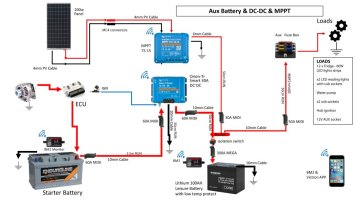This is my current set up in my 2018 Caravelle, a mess of wires of a Factory specced Eberspacher Auxiliary air heater and 2nd battery, plus a few extras fitted by the previous owner, all under the passenger seat:
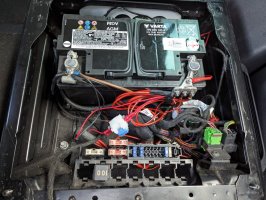
This is the wiring diagram as it sits:
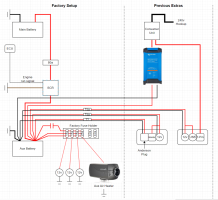
I've got the standard split charge relay, and the 75Ah AGM battery feeding 3x 12v USB ports and the air heater, from factory. It's also feeding an Anderson connector, basic battery monitor, and 12v socket on a passenger seat board:
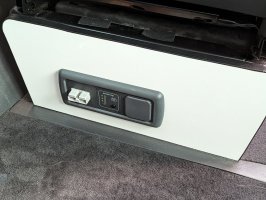
And a 12v socket and dual USB socket on the drivers seat board:
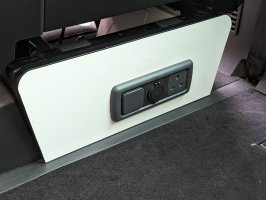
Also under the driver's seat is a 240v consumer unit with hook up lead under the bonnet, going to a Victron IP22 12/15 1 output charger and a 3 pin plug under the driver's seat.
As it is, with the limitations of the SCR, my 75Ah AGM battery only has 22.5Ah of usable capacity.
I'm currently building a kitchen pod which will have in it, a CRX50 fridge, plus some LED lights, a couple of USB ports and a submersible pump for water.
So, I want to upgrade my current set up slightly - mainly getting some proper battery monitoring via a Victron BMV-712, and as they seem to be short on stock until march I'll probably try and pick up the new Victron XS 50a B2B charger.
Also adding (moving) the Anderson connector on the passenger side to the drivers side so I can use that as a single connection for my kitchen pod.
This would mean I'd have a whole 37.5ah of battery capacity at my disposal!! And, crucially, I'd be in a much better place to be able to upgrade to a LiFePO4 battery and/or add solar in the future.
I'm aiming to be able to go away for 2-3 nights and I'd like to have a fridge and lights/water for that time. I know I'll need either solar or a bigger battery to really do this properly without having to drive, however I'll be driving a bit on a normal 2 or 3 day trip so should be ok for now.
So, proposed set up is below:
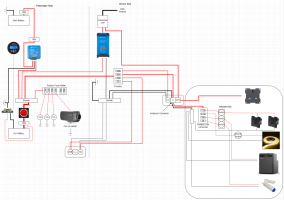
The main changes are a master 150a Megafuse and isolator switch on the LB.
Positive connections all going to a Busbar under the passenger seat.
DC-DC Victron charger in place of the SCR
Victron BMV-712
Factory fuse box etc tidied up under the passenger seat so that if (when) I upgrade to a LiFePO4 battery I'll just be able to slot a seatbase battery in! Yeah, ok... maybe not quite that easy!
Then under the driver's seat:
Fusebox for all the auxiliary non factory stuff, so the USB, 2x 12v sockets and the Anderson connector.
A negative Busbar for the above auxiliary stuff, and the battery charger.
I'm probably missing some fuses, bearing in mind the longest run of any wiring will be between the front seat bases.
And I'll need to check on what size wires I need, hopefully I'll only need 3 sizes: big beefy boy for the negative battery connection to the BMV712 shunt and to the chassis ground, and the same size for the Megafuse and isolator to bus bar. Then some 60a rated stuff for the DC-DC charger and Anderson connector, then 20a rated stuff for everything else.

This is the wiring diagram as it sits:

I've got the standard split charge relay, and the 75Ah AGM battery feeding 3x 12v USB ports and the air heater, from factory. It's also feeding an Anderson connector, basic battery monitor, and 12v socket on a passenger seat board:

And a 12v socket and dual USB socket on the drivers seat board:

Also under the driver's seat is a 240v consumer unit with hook up lead under the bonnet, going to a Victron IP22 12/15 1 output charger and a 3 pin plug under the driver's seat.
As it is, with the limitations of the SCR, my 75Ah AGM battery only has 22.5Ah of usable capacity.
I'm currently building a kitchen pod which will have in it, a CRX50 fridge, plus some LED lights, a couple of USB ports and a submersible pump for water.
So, I want to upgrade my current set up slightly - mainly getting some proper battery monitoring via a Victron BMV-712, and as they seem to be short on stock until march I'll probably try and pick up the new Victron XS 50a B2B charger.
Also adding (moving) the Anderson connector on the passenger side to the drivers side so I can use that as a single connection for my kitchen pod.
This would mean I'd have a whole 37.5ah of battery capacity at my disposal!! And, crucially, I'd be in a much better place to be able to upgrade to a LiFePO4 battery and/or add solar in the future.
I'm aiming to be able to go away for 2-3 nights and I'd like to have a fridge and lights/water for that time. I know I'll need either solar or a bigger battery to really do this properly without having to drive, however I'll be driving a bit on a normal 2 or 3 day trip so should be ok for now.
So, proposed set up is below:

The main changes are a master 150a Megafuse and isolator switch on the LB.
Positive connections all going to a Busbar under the passenger seat.
DC-DC Victron charger in place of the SCR
Victron BMV-712
Factory fuse box etc tidied up under the passenger seat so that if (when) I upgrade to a LiFePO4 battery I'll just be able to slot a seatbase battery in! Yeah, ok... maybe not quite that easy!
Then under the driver's seat:
Fusebox for all the auxiliary non factory stuff, so the USB, 2x 12v sockets and the Anderson connector.
A negative Busbar for the above auxiliary stuff, and the battery charger.
I'm probably missing some fuses, bearing in mind the longest run of any wiring will be between the front seat bases.
And I'll need to check on what size wires I need, hopefully I'll only need 3 sizes: big beefy boy for the negative battery connection to the BMV712 shunt and to the chassis ground, and the same size for the Megafuse and isolator to bus bar. Then some 60a rated stuff for the DC-DC charger and Anderson connector, then 20a rated stuff for everything else.
Last edited:

